| Green Spring House Fairfax County, Virginia Built 1784-86 |
||||||||||||||||||||||
|
by Debbie Robison January 31, 2008 | ||||||||||||||||||||||
| COLONIAL FARM |
| Two
hundred and seventy-five years ago, more than a century before Green Spring
Farm even acquired its name, the land was under British rule and formed part of
the British colony of The
following year, John Summers and two of his slaves constructed a tobacco warehouse
for Hugh West on the future site of It
is also feasible that Mr. Summers may have cultivated wheat to be ground at a
mill on Turkey Cock Branch. The mill was described as an old mill in a 1761 deed. [4]
In
1743, John Summers and George Harrison acquired an 843-acre grant adjacent to
Summers’s 201 acre grant. 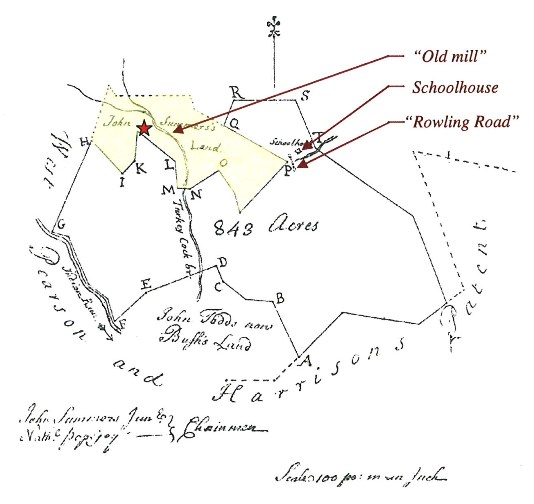
George
Harrison and John Summers divided the 843-acre grant in 1748. John Summers
received the northern portion that was contiguous to his 201 acre grant.[5]
His tract was located on a principal roadway that extended from the west to Ordered that
the Tithables which cleared the Church road do clear the road from Accotink to
Cameron whereof John Summers is Surveyor [6] On
February 19, 1761, John Summers divided the land between his sons Francis and
Daniel Summers. Daniel Summers acquired the western parcel. The approximate
bounds of his tract are depicted below, overlaid on a 1937 USDA aerial photo.[7]
Francis Summers received the eastern parcel on which the Summers’ established a
cemetery. John Summers died in 1790 at the age of 102 years. His son, Francis,
died in 1800. They are both buried in the 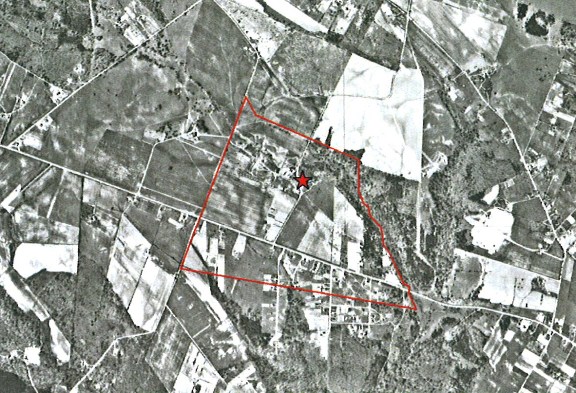
Aerial Photo Courtesy Fairfax County Park Authority It
is unknown what Daniel Summers did with the land. His name was never recorded
in the road order books like his brother Francis. His ownership lasted sixteen
years until he sold the tract on September 11, 1777 to a neighbor, John Moss,
who had been living as a tenant farmer in the area as early as 1753.[8] MOSS FAMILY OWNERSHIP 1777-1840 |
| John
Moss constructed the brick Green Spring house during the period 1784-86.[9]
Moss, in addition to being a Commissioner of the Land Tax, also served as a
justice of the county court. [John Moss was not the only man in the area to
bear his name, hence caution should be taken in attributing occupations and
events to one person.] John
Moss increased his farm acreage by acquiring 250 acres from Baldwin and
Catherine Dade in 1788.[10]
The land adjoined his 200 acres to the south expanding the size of the farm to
450 acres. Moss gave 150 acres of the southern portion of the two-parcel tract
to his son Robert about 1802 and another one-third to his son William in 1809.[11]
From the description provided in John Moss’s will of 1809, it appears that son Thomas
Moss was bequeathed the northern one-third of the two-parcel tract to be owned
by him following the death of his mother, Ann.[12]
Based on the tax records, 138 acres of land were transferred to Thomas Moss in 1815.
William Moss sold his portion of the two-parcel tract to his brother Thomas.[13]
The deed was recorded in 1828, but tax records show that the transfer occurred
by 1818. It
should be noted that William Moss purchased 310 acres from Colonel Smith in
1811 that had been part of the Ravensworth tract. The parcel, known as Aspen
Hill, was located at the intersection of the Little River Turnpike and the City
Road (now known as Old Columbia Pike) where he resided and also operated a
brick tavern. William Moss’s estate inventories, sited in previous histories, would
have reflected what he possessed at Aspen Hill.[14] The
Little River Turnpike was built passing through the Moss Farm sometime between
1802, when the turnpike company was chartered, and 1806. Thomas Moss served as
a director of the company and arranged for repairs to the road in the lower
district near his home.[15]
In
1828, Thomas Moss was a delegate to the Virginia State Assembly. He also served
as Thomas
Moss made improvements to the buildings on his property. In 1827, the building
value noted in the land tax records increased from $2,000 to $2,160 due to
unspecified improvements. The building values increased again in 1830 to
$2,340, this time the cause was noted as new buildings added. By
the 1790s, farmers like Moss were no longer growing tobacco. Moss converted to
grass cultivation. Tobacco was no longer
economically feasible for many farmers. Tobacco depleted soils and had limited
markets, while grains became in high demand during the Napoleonic Wars. Tobacco
was also a labor-intensive crop. In 1820, Moss had 22 slaves, 14 of them male,
to work on his farm and other enterprises. In
an 1831 advertisement, Moss boasted of several new buildings on the road and
noted that the land was suited for dairy farming. Land for The
subscriber, being desirous of removing to the West, wishes
to sell his LAND,
in containing
upwards of 300 acres, lying im- mediately on
both sides of the Little River Turnpike
Road, five and a half miles from Alexandria;
one half of the same is in wood, part of it heavily
timbered. The cleared land lays well – well watered –
and great part in a good state of cultiva- tion. The
Dwelling is a Two-story
BRICK HOUSE, with four rooms and a passage on each floor; and brick kitchen; the out houses comforta- ble; good orchard, &c. On the Road a gon stand, inferior to none on the Road, with good frame buildings of six rooms and kitchen, four of the rooms 16 feet square, & frame wheelwright shop
and blacksmith’s shop, and smith’s dwelling house of four rooms and kitchen, all new. The neighborhood healthy and agreeable. To a person who would wish to establish a dairy farm, there is none more suitable in the county, as
it is first rate grass land, and a spring affording as
much pure water as any in the county, within seventy yards of the door, with a good stone spring house. Fifty tons of hay may be cut annually, and a great deal
more with a little expense
Persons wishing to purchase the abovementioned farm, will apply to the subscriber on the premises. THO
MOSS, jy 2 – colm Fairfax
County, Va: The National Intelligencer will
publish the above three
times a week for one month. [17] Moss
advertised his property for sale because he wished to move to the West. From
1810 to 1830, the population of Following
Moss’s death, the property was advertised for sale by court-appointed
commissioners in 1839. Following is a excerpt from this advertisement. COMMISSIONER’S Pursuant to
a decree of the Circuit Superior Court of Law and Chancery for …will sell
at Public Acution…the Tract of LAND … containing
about three hundred and twenty Acres, more
or less, lying on both sides of the Little one half of
which is in Timber, the residue in a good state
of cultivation, a considetable por- tion in
Grass to which it is admirable adapted. The
buildings consist of a Brick Dwelling House,
containing eight rooms, Brick Kitchen, Meat House,
Servants’ House, a new Barn and Stables,
with other convenient Out-houses. There is also an Apple Orchard of well se- lected
Fruit, and a Peach Orchard inferior to none perhaps
in the County. The Land is well watered
having numerous never failing springs upon
it, one of which is near the dwell- ing, where
there is a stone Spring house. There is also a
wagon house and Blacksmith shop, on the said
Turnpike, both in good repair. Con- sidering the
proximity of this land to the Dis- trict
markets, with its other advantages, few situations
in the county are more eligible. [19] SHERIFF FAMILY OWNERSHIP 1840-1855 |
| From
1838 – 1843, 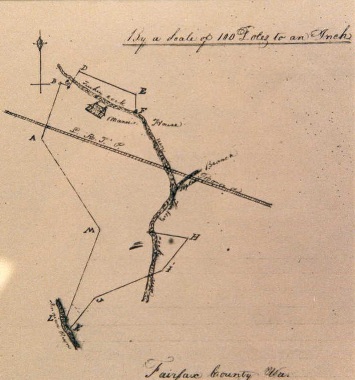
At
the death of Thomas Sheriff, his son James acquired the property as a reversion
after the death of his mother, Jane.[22]
James Sheriff suffered financial difficulties causing him to enter into several
trust agreements. In 1852, the land north of Turkey Cock Branch was placed in
trust with Daniel Minor for the security of James’s brother, William.[23]
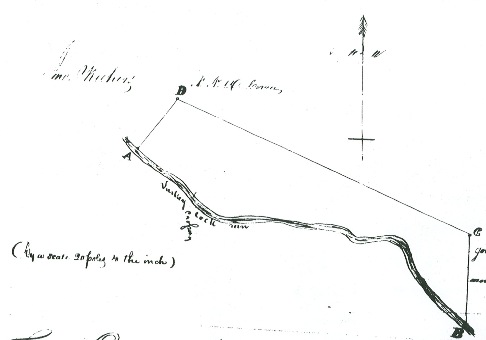
In
July 1853, James placed the entire farm known as Green Springs in trust on behalf of Richard B. Lloyd of Lloyd &
Co.[24]
This is the first known use of the Green Spring(s) name. The following month
James’s mother, Jane, paid James $6,500 for his reversion excepting the mortgage
to Lloyd & Co. She paid $2,000 initially and agreed to pay the balance in
three equal payments.[25]
In
November 1853, Lloyd & Co. advertised the farm for sale. We are
authorized to offer a valuable Farm of 320 acres, beautifully located on the
Little River turnpike, and one mile from the railroad leading to A
dispute arose between James Sheriff and Lloyd & Co. regarding whether Lloyd
& Co. had a right to sell the land. James Sheriff placed his own
advertisement in the same issue of the Alexandria Gazette stating that Lloyd was
not authorized to sell his land. As
a result of the dispute, James’s brother William purchased the tract from Jane
and James Sheriff. William Sheriff resided in …that
valuable and well known FARM, called Green Springs, lately the residence of
James Sheriff, (formerly Moss’s Farm,) …The Alexandria and Manassas Gap Rail
Road will pass through a corner of the tract, and a depot within five minutes
walk…The improvements consist of a TWO-STORY DWELLING HOUSE, kitchen, smoke,
spring and other OUT-HOUSES – and Orchard of excellent fruit, Garden, &c.
The soil is excellent and easily improved, and from the proximity to HANNAH O’BRIEN OWNERSHIP 1855-1878 |
| On
September 10, 1855, Hannah O’Brien purchased Green Spring. The property was
held in trust by James Benton, free of Hannah’s husband Matthew O’Brien.[29]
James Benton was a near neighbor who operated a steam saw-mill in Hannah
advertised the property for sale in 1859, but it was not sold. As a result, Hannah
owned the property throughout the Civil War. The very
desirable FARM known as “GREEN SPRING”…contains 341 ACRES, 140 of which is in
Wood, the remainder in a high state of improvement; 100 acres is well set in
Clover and Timothy, and will produce a good crop of Hay another year. It is
well supplied with the different kinds of Fruit, and a thrifty young ORCHARD
that will soon bear. The improvements are good; Churches, &c., convenient,
and for Farming, Gardening, or Dairy purposes, this Farm is not surpassed by
any in this section of the country. The location is healthy and very desirable,
and well supplied with a full supply of pure Spring water. George R. Padgett,
on the premises, will show it to any one desiring to purchase…[31] 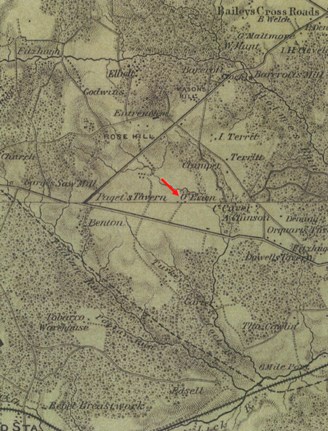
Image Courtesy Library of Congress Hannah
O’Brien ended her ownership of the property due to the court case H. C. O’Brien
vs. John W. Green. The court appointed commissioners, H. O. Claughton and F. L.
Smith, had the farm surveyed by R.R. Farr in 1874.[32]
…improved by
a TWO-STORY BRICK DWELLING, Frame Barn and other out-buildings, necessary and
valuable to a farm. The farm is well located and finely watered. [33] 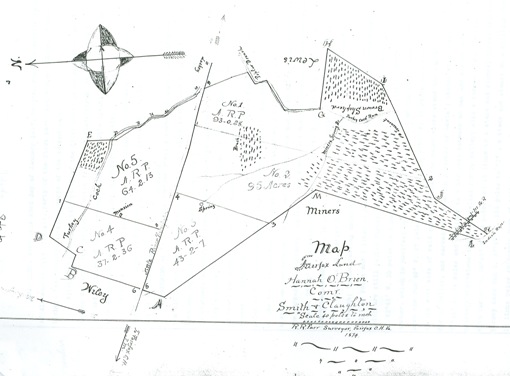
FOUNTAIN BEATTIE OWNERSHIP 1878-1917 |
| 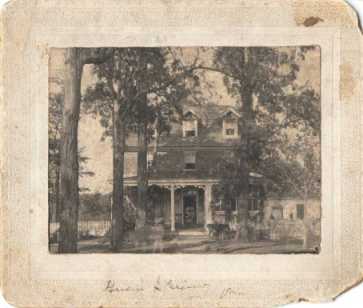
Courtesy Fairfax County Park Authority As
the result of the court case, the land was sold to Fountain Beattie, a former
Civil War lieutenant who rode as a guerilla-style raider with his friend,
Captain John Singleton Mosby.[34]
Fountain
Beattie’s son, John Mosby Beattie, recalled later in life that his father
operated a combined dairy and apple orchard business utilizing day workers both
on the farm and in the house. The farm products, including milk and butter,
were delivered by wagon to the markets in 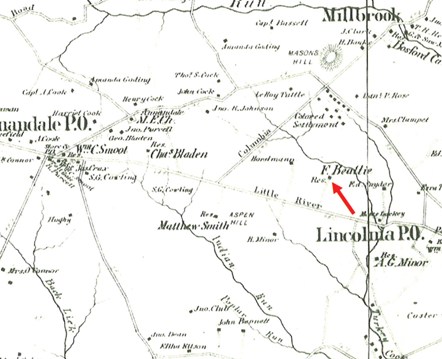
After
a fire about 1890 destroyed the stock barn and its contents (stock, hay, and
feed), the financial strain resulted in the demise of the dairy business.
Afterward, Beattie purchased only sufficient horses, mules, and cows for the
farm and family needs.[36] Fountain
Beattie and his wife, Anne, lived in the house with their twelve children, six
boys and six girls. To provide heat, there was a coal stove set in the living
room fireplace. A pot-bellied stove provided the heat in the dining room. There
was no heat upstairs except what rose from the lower floors or was supplied by
fireplaces.[37] In
order to accommodate their large family, Beattie converted the attic level to
living space by finishing off the space for bedchambers. Dormer windows were
installed that provided additional light and air sometime after 1878.[38]
Perhaps it was at this time that a porch, seen in a c. 1885 photo, was added to
extend along the southern façade of the house. The windows of the porch and the
dormer windows are of a similar style. From
1875-1914, Beattie worked for the Bureau of Internal Revenue as a Deputy
Collector for the Sixth District of Virginia.[39]
In 1899, Capt. Fountain Beattie, of the
revenue office, discovered magnetic iron ore and copper while raiding
moonshiners in the Field
Captain F. Beattie, whose early activities helped to make John Mosby famous,
said to have retired, has opened an office in Alexandria, and may be seen most
any fine day with a load of real estate on his shoulders, hustling around town
like a youngster. [42] Towards
the end of his ownership of Green Spring, Fountain Beattie lived in From
1911 to 1913, Beattie leased Green Spring to George Daniel and Joesphina
(Josie) McClanahan and their six children. Mrs. McClanahan used the enclosed
porch, which she called a sunroom, as a sewing room. One of the children died
in infancy and was reportedly buried in a rose garden at Green Spring.[45] INVESTMENT PROPERTY 1917–1924 |
| In
1917, George Sims and his wife Marjorie B. Sims purchased the farm from
Fountain Beattie, a widower at the time. The Sims’ were living in James
Duncan and his wife Mary owned the farm for 2 years before they entered into a
trust agreement with Carroll Pierce to subdivide the property and sell small
tracts. The land was advertised to be auctioned off on June 23, 1924, and was
identified as THE OLD CAPTAIN BEATTIE
FARM ON the The Beattie residence has 10 rooms.
There is one 250 ton Silo, Large Barn, Chicken House, Spring House and a young
orchard of 10 acres on the property. Also spring house with very large spring
of excellent water… SEGESSERMAN OWNERSHIP 1924–1931 |
Frederick Segesserman purchased Lot
Numbered 13, containing 28 acres, from Carroll Pierce for $4,620; being the
highest bidder when the sale was cried off. The deed stipulated that This conveyance is made upon condition which
shall be construed as a covenant running with the land, that the said land
shall not be sold or leased to any person of African descent.[47] |
The Green Spring dwelling remained
unoccupied for several years. Segesserman, who lived in Burke, took steps to
protect the house from further vandalism until someone was interested in
purchasing the property for use as a home. Much of the interior was damaged and
the hand-carved mantels were taken;
however, Segesserman recovered them and put them in storage. His preservation
efforts were described in a 1929 Fairfax Herald newspaper article. |
| Preserving
Old Home Owner of
Former Beattie Home Will Prevent Vandalism The old brick
dwelling, on the north side of the Little River pike, about a half mile this
side of Annandale, for many years the home of the late Capt. Fountain Beattie,
is one of the oldest homes in Fairfax county, but since it has been without
occupants, it is stated, it has been visited by vandals and the interior much
damaged. Hand carved mantels were taken, but M. Segessenman of Burke, who is
now the owner of the old structure, recovered them and has them in safe
storage. Precautions have been taken to prevent further depredations and the
old building is to be preserved, until some one comes along who wishes to
purchase it for a home…[48] MINNIE WHITESELL OWNERSHIP 1931–1942 |
| Minnie
Whitesell purchased Green Spring in 1931 in the midst of the Great Depression,
which had begun 2 years prior. Photographs taken near the time of her purchase
of the property show the house in a dilapidated condition. By
1932 Ms. Whitesell was renovating the house, as noted in a 1932 article in the American
Motorist magazine. Old Moss
house… now being prepared for occupancy after being in ruins for many years…It
has three stories with dormer windows, and the many coats of whitewash on the
front testify to where a columned porch once stood. For half a century it has
been known as the Beattie farm, as about fifty years ago Captain Fontaine
Beattie bought this old home with more than 300 fertile acres. For years those
who traveled the Little River turnpike missed seeing this old home as it was
hidden by an osage orange hedge, extending a quarter of a mile along the pike.
Now that the present owner is pruning the old hedge, visitors have the
privilege of peering at the landmark, which is being renovated for occupancy
after being in ruins for many years. Yes, it is desolate when its windows were
out and its porch had rotted and collapsed, but even then its center hall had a
kind of hospitality. The many open fireplaces, and windows reaching to the
floor…Green Spring farm became a mecca during the drought of 1930, when neighbors
for miles around wore beaten paths to the old spring behind the homestead…As
they carried barrels of water they were still impressed with the beautiful
setting of willow trees around the spot…[49] After
architect Mr. Wiley told Mrs. Whitesell that the house could be salvaged a
carpenter was hired. John Pence, who worked as Mrs. Whitesell’s handyman,
traveled to Haymarket with a crew to tear down a house. Some of the 12” boards
from this house were used in the Green Spring dwelling. In
addition to repairs, Mrs. Whitesell installed a bathroom on the second floor,
relocated a log house to the property, and built a garage close to the house.
The privy was located near the northwest corner of the house. Mrs.
Whitesell was a widow who lived at Green Spring Farm with her two children,
Russell and Deana. The children lived with their mother during her ownership of
Green Spring, since neither child married. Minnie Whitesell was discovered dead
in an upstairs area of the house by her children, who subsequently sold Green
Spring to Michael and Belinda Straight.[50] 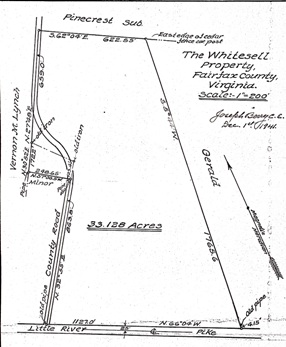
STRAIGHT OWNERSHIP 1942-1970 |
| Soon
after the Straights acquired the property, they hired historical architect
Walter Macomber to rehabilitate the brick dwelling. While construction was ongoing
at the brick dwelling, the Straights lived in the springhouse cottage. They
moved into the brick dwelling in late 1942, but only for a couple of months
before Michael Straight was called up for Air Force duty in January 1943. During
World War II, from 1943 – 1948, the Straights rented out Green Spring until
they returned in 1948. Later, the house was rented to Leonard Garment,
President Nixon’s counsel, when the property was donated to the Fairfax County
Park Authority in October 1970. Garment had been renting the house for about 5
years.[51] Oral
interviews with Macomber, the Straights, and Mrs. Quast, the caretaker’s wife,
provide an understanding of some of the changes made to the structures.[52]
The Straights lived at the springhouse cottage while construction was underway
on the brick dwelling in 1942. The cottage was enlarged in 1960. The Straights
converted the ice pond used by the Beattie’s into one of their two ornamental ponds.
Michael Straight commented about the fermentation tank in his interview that when we got there the whole slope behind the
house was dotted with very old and unproductive apple trees. And when we went
down to the house by the river - which was not a house but just walls - we
found within these walls we found very heavy and beautifully painted beams...It
turned out to be a brandy press. In
an oral interview, John Mosby Beattie recollected a large concrete tank for apple cider, jack and brandy. CONSTRUCTION DATES |
| Brick Dwelling Construction The
original portion of the brick dwelling that stands today was likely built during
the period of 1784-86 as a center-passage double-pile house; that is, the
center hall was flanked by two rooms on each side. The wood framing members are
pit sawn and connected with mortise and tenon joinery, while the collar ties
are notched into the rafters with a lap joint and secured to the rafters with
rosehead, chisel-point nails. The irregular sizes and texture of the brick used
at Green Spring resulted in irregular mortar joints and a less than perfect
alignment of the Flemish bond pattern. Springhouse and Brick Kitchen Construction The
1831 sale advertisement contains the earliest known references to a springhouse
and kitchen. The springhouse is described as a good stone springhouse and the kitchen as constructed of brick. The
date of construction of these structures is unknown. Perhaps the brick kitchen
was added to the dwelling in 1827 when the value of Thomas Moss’s buildings, as
recorded in the land tax records, increased from $2,000 to $2,160.[53] Fermentation Tank The
fermentation tank is shown in c. 1900 photos. Further investigation of tax
records and liquor licenses from this time period may yield a construction
date. [1] Northern
Neck grant to John Summers for 201 acres, Book D, p. 37, Library of Virginia
website http://ajax.lva.lib.va.us, [2] [3] Northern
Neck grant to George Harrison and John Summers for 843 acres, Book E, p. 217,
Library of Virginia website http://ajax.lva.lib.va.us,
[4] [5] FX DB
B:372, Division between [6] Beth
Mitchell, Fairfax County Road Orders 1749-1800, Virginia Transportation
Research Council, Charlottesville, Virginia, 2003, p. 222; [7] FX DB
D:829, John Summers to Daniel Summers, [8] Beth
Mitchell, “ [9] Dr. Edward R. Cook, William J. Callahan, Jr., and Dr. Camille Wells, Dendrochronological Analysis of Green Spring House, Alexandria, Fairfax County, Virginia, January 2008, p. 3. [10] FX DB
R:256, Baldwin and Catherine Dade to John Moss, [11] FX DB
D2:272, Robert Moss gift from John Moss, about 1802; and FX DB J2:272, William
Moss gift from John Moss, [12] [13] FX DB
X2:309, William Moss to Thomas Moss, [14] FX Land Tax, 1811; A survey of this tract is recorded in FX DB F3:3. [15] Ross
and Nan Netherton, Green Spring Farm, [16] Green
Spring National Register of Historic Places Registration [17] Thomas
Moss, “Land for [18]
Patricia Hickin, [19] T.R.
Love, Alfred Moss, Com’s, “COMMISSIONER’S SALE OF LAND,” Alexandria Gazette, [20] USDA, “
Economic Cycles,” A History of [21] FX DB
H3:226, [22] [23] FX DB
S3:106, [24] FX DB
S3:362, [25] FX DB
T3:34,35, [26] Lloyd
& Co., [27] FX DB
T3:291, [28] William
Sheriff, Alexandria Gazette and Virginia
Advertiser, [29] FX DB
W3:424, [30] Fairfax
News, Alexandria Gazette, [31] John H.
Monroe, “Valuable Farm for [32] FX DB
C8:446, [33] Receipt
payable to the [34] FX DB
W4:271, [35] John
Mosby Beattie Interview with Ross and/or Nan Netherton, [36] Ibid. [37] Ibid. [38] [39] Unknown
author, “A Brief History of the Life of Fountain Beattie,” undated, [40] “ [41] Ibid. [42] [43] [44] Unknown
author, “A Pictorial History of the Beattie Family,” undated, [45] Unknown
author, “Notes from Meeting with Mr. and Mrs. John Pence,” undated, [46] John C.
Wagner, “I will sell At Absolute Auction,” Fairfax
Herald, [47] FX DB
J9:23, [48]
“Preserving Old Home,” [49] Katherine Malone Willis, “Old Fairfax Homes Give Up a Secret,” American Motorist, May 1932, p.16. [50] Unknown author, “Notes from Meeting with Mr. and Mrs. John Pence,” undated, FCPA Green Spring Gardens Park Collection. [51] Ed
Peskowitz, “ [52] Nan
Netherton, “Interview on [53] Fairfax
County Land Tax book, 1827, Fairfax County Circuit Court Archives, |

